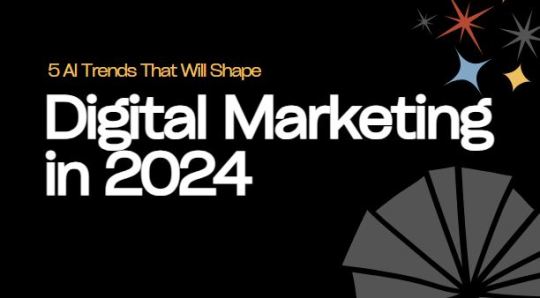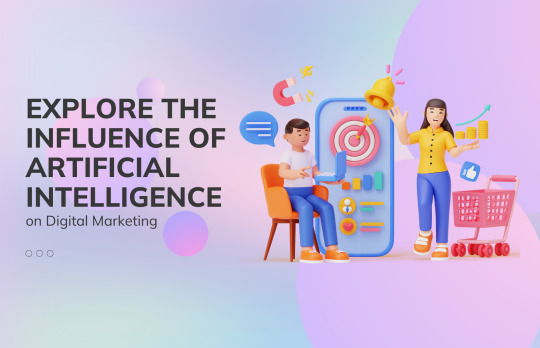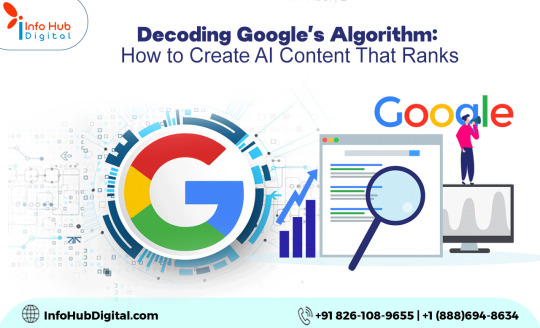#AI algorithms in digital marketing
Explore tagged Tumblr posts
Text
In the realm of SEO, the battle between AI and human expertise is intensifying. Explore the dynamics, advantages, and limitations of both, shedding light on the ongoing competition for superior SEO. Dive into the nuances of automated algorithms versus human intuition, and discover how businesses can leverage both for optimal search engine success.
#AI in SEO#AI-driven SEO#Machine learning in SEO#SEO automation#Artificial intelligence for search engine optimization#AI algorithms in digital marketing#Automated SEO strategies#Impact of AI on search rankings#SEO tools with AI capabilities
0 notes
Text
Social Media Trends 2025: What Businesses Can Learn from Service Zoom

In today's competitive digital landscape, staying relevant on social media is no longer a choice—it’s a necessity. As algorithms shift, new platforms emerge, and consumer expectations evolve, 2025 is shaping up to be a pivotal year for businesses to either adapt or get left behind.
So, how do you keep up with the fast-paced world of social media marketing? That’s where the expertise of Service Zoom becomes invaluable. With a finger firmly on the pulse of industry trends, Service Zoom is helping businesses of all sizes translate social activity into real, measurable growth.
Below, we explore the top social media trends for 2025—and how Service Zoom helps businesses not only understand them but leverage them effectively.
1. AI-Powered Content Creation is the New Normal
In 2025, artificial intelligence (AI) plays a critical role in creating content that is smart, targeted, and personalized. AI tools are being used to:
Predict audience preferences
Create data-driven content calendars
Generate tailored captions and visual recommendations
Analyze past post performance for better future planning
Service Zoom uses cutting-edge AI to build and execute content strategies that feel human but perform with machine precision. This enables businesses to maintain consistent posting, higher engagement, and a unique brand voice—all with maximum efficiency.
2. Micro-Influencers are Replacing Celebrity Endorsements
Forget mega-celebrities with millions of followers. In 2025, micro-influencers (accounts with 5K–50K followers) offer better engagement, more authenticity, and tighter community ties.
Service Zoom helps businesses:
Identify niche influencers aligned with brand values
Build mutually beneficial collaborations
Track ROI from influencer campaigns
With this approach, businesses achieve better visibility in highly targeted communities, increasing both trust and conversion rates.
3. Short-Form Videos Still Rule the Feed
From TikTok trends to Instagram Reels and YouTube Shorts, short-form video content continues to dominate social media in 2025.
Consumers crave snackable, visual content that delivers entertainment or value within seconds. Service Zoom’s content team specializes in crafting professional, eye-catching video content that fits your brand and stands out in a sea of scrolling.
Whether it’s behind-the-scenes footage, tutorials, testimonials, or trending challenges, Service Zoom ensures your videos are optimized for reach, relevance, and retention.
4. Social Commerce Is the Future of Shopping
Social media is no longer just a discovery tool—it’s becoming the end-to-end customer journey. With features like Instagram Shop, Facebook Marketplace, and TikTok Shopping, users are making purchases without ever leaving the app.
Service Zoom helps businesses:
Set up and manage social storefronts
Create shoppable posts and stories
Optimize product visibility through hashtags and SEO
Run effective social commerce ad campaigns
This integrated experience removes friction from the buying process, leading to higher conversions and increased brand loyalty.
5. Community Building Over Broadcast Marketing
Today’s audiences want to be part of something—not just marketed to. Community-driven engagement is a major trend in 2025.
Service Zoom helps brands build strong digital communities by:
Facilitating user-generated content
Hosting live Q&As and interactive sessions
Managing groups and forums
Responding to comments and DMs in real time
This two-way engagement not only humanizes your brand but also builds a loyal audience that becomes your best advocates.
6. Data-Driven Marketing Decisions
In 2025, guessing is gone. Data is king.
Service Zoom provides in-depth analytics dashboards that measure:
Engagement rates
Follower growth
Ad performance
Audience demographics
Conversion tracking
These insights help businesses adjust strategies in real time, double down on what works, and minimize what doesn’t—ultimately leading to a higher ROI.
7. Hyperlocal Targeting for Maximum Impact
If you run a local business, geo-targeted content is essential. Consumers are more likely to buy from brands that feel local and relevant.
Service Zoom uses hyperlocal tools to:
Run location-specific ad campaigns
Promote events, offers, and announcements to nearby audiences
Boost your local SEO through geo-tagging and maps integration
This allows small businesses to dominate their local market while keeping ad costs low and conversions high.
The Service Zoom Advantage
What makes Service Zoom stand out is their ability to turn complex trends into easy-to-execute strategies. Whether you're a startup looking to build brand awareness or an established business aiming to scale online, Service Zoom offers:
Customized social media marketing plans
Daily account management
Performance tracking and reporting
Ad campaign setup and optimization
Influencer outreach and content planning
They don’t just keep up with trends—they make them work for you.
Final Thoughts: Stay Ahead, Not Behind
The social media space in 2025 is packed with potential. But without the right partner, it can also be overwhelming. Don’t get left behind—learn, adapt, and grow with the expert guidance of Service Zoom SMM.
Whether it’s building your brand voice, launching a product campaign, or growing your followers organically—Service Zoom is your digital partner for real growth in the modern era.
#Social media trends 2025#Future of digital marketing#AI in social media#Service Zoom insights#Social media strategy 2025#Influencer marketing trends#Small business marketing tips#Short-form video marketing#Personalized social content#Social commerce growth#Platform algorithm changes#User-generated content strategy#Real-time engagement tactics
0 notes
Text
What is the Future of SEO in the Age of AI?

1. AI is Changing Search Engine Algorithms
Search engines like Google are using AI to improve how they work. BERT, MUM, and RankBrain are just the start. These systems help search engines grasp what users really mean, beyond just matching keywords. With Natural Language Processing, AI can understand queries in a more human way.
Now, AI ranks pages based on user experience, mobile-friendliness, and the overall quality of content.
With real-time updates to algorithms, SEO strategies need to be adaptable. Students in digital marketing course in Coimbatore are learning how to make their content fit these new algorithms.
2. Working with AI in Content Creation
AI is changing how we create content. Tools like ChatGPT and Jasper can whip up text quickly, but Google still prefers original insights from real people. Use AI to brainstorm ideas and gather research.
Always tweak AI-generated content to make it more relatable and engaging. Make sure it aligns with Google’s guidelines for helpful content.
While AI can be a great helper, the future is for those who mix it with creativity—something emphasized in digital marketing courses in Coimbatore.
3. Voice Search Optimization
Voice assistants such as Siri, Alexa, and Google Assistant are becoming popular, leading to longer, more conversational search queries. To optimize for voice search, use natural language and long-tail keywords.
Creating FAQ-style content and using schema markup can help too. Voice SEO is becoming a big topic in digital marketing training in Coimbatore.
4. Machine Learning and User Behavior
Search engines are leaning on machine learning to tweak results in real-time. This means that SEO is about more than just technical aspects; user interaction matters too.
Metrics like bounce rate and session duration can affect your rankings. Content that keeps users engaged is prioritized now. Keeping an eye on user behavior and analytics is essential, and many digital marketing programs in Coimbatore now teach UX/UI basics to prepare students for this shift.
5. The Rise of Visual and Video SEO
AI can now see images and videos, leading to new ways of indexing visual content. Using alt text and proper file names is crucial.
Don’t forget to include video transcripts and descriptions while ensuring fast loading times and mobile optimization. With platforms like YouTube and Pinterest on the rise, it’s vital to optimize all content types, not just written stuff.
6. Predictive SEO with AI Tools
AI helps with predictive analytics, letting marketers guess search trends and ready content ahead of time. Tools like Google Trends and predictive SEO software can be handy here.
Spotting content gaps and planning for them will be key, especially with seasonal or event-based strategies. Good digital marketing courses in Coimbatore focus on hands-on experience with these tools.
7. E-E-A-T: Expertise Matters
Even with AI’s growth, Google’s E-E-A-T guidelines (Experience, Expertise, Authoritativeness, Trustworthiness) are still important. Make sure to highlight real authors and credentials.
Adding customer reviews and expert insights adds authenticity. Learning how to balance AI and genuine content is a skill taught in digital marketing courses in Coimbatore.
8. Improved Local SEO with AI
AI is making local SEO better by helping to create more accurate geo-targeted content. It’s crucial to optimize your Google Business Profile, include location-based keywords, and encourage reviews for local visibility.
For students in digital marketing training in Coimbatore, local SEO is especially critical for helping nearby businesses grow.
9. The Importance of LSA Keywords
Latent Semantic Analysis (LSA) keywords help search engines understand content context better. Here are some examples connected to SEO:
- search engine optimization tools
- AI in content marketing
- user behavior analytics
- mobile-first indexing
- semantic search trends
Using LSA keywords is important for creating content that fits the needs of both users and search engines.
10. Job Opportunities in AI-Driven SEO
As AI takes a bigger role in SEO, companies look for folks who understand both digital marketing and AI. Entry-level positions are starting to require knowledge of AI tools.
Internships now often include automation tools, analytics, and AI content optimization. Courses in Coimbatore are adapting their programs to reflect this demand. Hands-on training, tools, and project-based learning are becoming the norm.
Conclusion: Staying Ahead with Xplore It Corp
So, what’s the future of SEO in the age of AI? Clearly, while AI is making things faster and more efficient, human creativity and flexibility are essential. The need for skilled SEO professionals is rising, and it's important to keep evolving.
To keep your skills sharp, think about joining a digital marketing course in Coimbatore, or check out top training institutions in the area. Gain practical experience with real-world tools and expert guidance.
At Xplore It Corp, we offer training that combines traditional SEO with today’s AI technologies, prepping you for both the current job market and what’s to come. Join us to step into the future of digital marketing confidently!
FAQs About the Future of SEO and AI
1. Is SEO becoming outdated because of AI?
No, SEO is changing, not disappearing. AI is reshaping how search engines function, focusing more on user intent and content quality.
2. Can AI write good SEO content?
AI tools like ChatGPT can help create content, but you still need a human touch for it to be engaging and unique.
3. Which skills are vital for AI-driven SEO?
Key skills include knowledge of AI tools, data analysis, voice search optimization, and UX/UI. These are often covered in digital marketing course in Coimbatore.
4. How does AI impact local SEO?
AI improves local SEO by enabling real-time targeting and personalized user experiences through voice search.
5. Where can I learn SEO with AI tools in Coimbatore?
Check out Xplore It Corp for in-depth training on integrating SEO with AI resources.
#AI in Digital Marketing#Voice Search Optimization#Content Marketing Trends 2025#Programmatic Advertising#Social Media Algorithms 2025#Influencer Marketing Strategy#Digital Marketing Career Opportunities#Marketing Automation Tools#Search Engine Algorithm Updates#Data-Driven Marketing
0 notes
Text
The Digital Euro in 2025: How This Game-Changer Will Impact Forex Traders
The European Central Bank’s plan to roll out the Digital Euro in 2025 is set to reshape the forex landscape. As a central bank digital currency (CBDC), it promises greater financial inclusion, enhanced security, and faster transactions. But what does this mean for traders? Will it create new opportunities or add more volatility to the market? PipInfuse, a leading Forex & Investment consultancy, explores how the Digital Euro could impact currency trading, offering expert trading solutions to help you navigate the changes.

What is the Digital Euro and Why Does It Matter?
The Digital Euro is a fully digital form of fiat currency issued by the European Central Bank (ECB). Unlike cryptocurrencies, it is centralised and backed by the EU, ensuring stability. The key objectives behind its launch include:
Reducing dependence on cash
Enhancing payment security
Strengthening the EU’s financial sovereignty
Offering an alternative to private digital payment solutions
For forex traders, this introduction means potential shifts in liquidity, volatility, and trading strategies.
Impact on the Forex Market
1. Liquidity and Volatility Shifts
The Digital Euro is expected to influence EUR trading pairs significantly. If widely adopted, it could increase liquidity in the forex market, making it easier to trade. However, during the initial rollout, uncertainty and speculation may create short-term volatility, presenting both risks and opportunities.
2. Changes in EUR/USD and EUR/GBP Dynamics
With the EU strengthening its monetary control, traders may see the Digital Euro influencing major forex pairs like EUR/USD and EUR/GBP. Any policy shifts by the ECB regarding CBDC interest rates or usage restrictions could impact price action, requiring expert market analysis to make informed trading decisions.
3. Effect on Forex Trading Strategies
Profitable forex strategies will need to adapt to the Digital Euro’s influence. Algorithmic trading models, liquidity forecasting, and AI-based analysis will become even more crucial. PipInfuse provides advanced forex tools and expert solutions tailored for all trader types, helping traders stay ahead of market changes.
4. Regulation and Transparency
The introduction of the Digital Euro could lead to stricter regulatory measures affecting brokers and forex trading platforms. While increased transparency may benefit traders, brokers offering unregulated services might face challenges. Trusted forex partners and copy trading solutions will become even more valuable for those looking to trade securely.
How Traders Can Prepare for the Digital Euro
Stay Updated with Expert Insights: Following reliable sources like PipInfuse ensures traders receive timely forex trading insights and expert market analysis on the Digital Euro’s impact.
Upgrade Trading Tools: As the forex market evolves, using advanced analytics and automation tools will be crucial for staying competitive.
Refine Risk Management: Increased volatility requires disciplined risk management. A well-structured forex trading plan is essential to mitigate potential losses.
Seek Expert Consultation: Understanding the broader economic impact of CBDCs can be complex. Free forex trading plan and expert consultation by PipInfuse can help traders develop strategies tailored to the changing forex landscape.
The Digital Euro marks a major shift in the financial world, with significant implications for forex traders. Whether it leads to increased liquidity, regulatory challenges, or new trading opportunities, being prepared is key. PipInfuse, an expert forex trading and investment consultancy, provides traders with the knowledge, tools, and strategies to navigate these changes confidently. By staying informed and leveraging expert trading solutions, traders can turn this disruption into a profitable opportunity.
Happy Trading
PipInfuse
#Digital Euro#Forex Trading#CBDC#Central Bank Digital Currency#Forex Market#EUR/USD#EUR/GBP#Forex Strategies#Risk Management#Advanced Forex Tools#Expert Trading Solutions#PipInfuse#Forex & Investment Consultancy#Forex Trading Insights#Market Analysis#Trusted Forex Partners#Copy Trading Solutions#Free Forex Trading Plan#Expert Consultation#Forex News#Trading Opportunities#Forex Regulation#Liquidity#Volatility#ECB#Algorithmic Trading#AI in Forex#Forex Brokers#Forex Education
0 notes
Text
Why Some Websites' Structured Data Cannot Be Detected by Google Rich Results?
Table of Contents Introduction Understanding Structured Data How Google Rich Results Work Common Issues with Structured Data Detection How to Fix Structured Data Errors AI Overview: Enhancing Structured Data with AI Featured Snippets & AEO Optimization GEO Targeting for Local SEO Impact FAQs About Structured Data and Google Rich Results People Also Ask (PAA) People Also Search…
#AI in SEO#digital marketing trends#digital-marketing#Featured Snippets#Google Rich Results#Google search visibility#Google structured data guidelines#Googlebot#JSON-LD errors#keyword-research#local SEO optimization#Marketing#organic-traffic#rich results test#rich snippets#schema markup#schema validation#search algorithm updates#Search Engine Optimization#seo#SEO audit#SEO expert tips#SEO optimization#SEO Ranking Factors#structured data issues#structured data troubleshooting#technical SEO#website indexing#website performance#website schema errors
0 notes
Text
🚀 Exciting news! Google has launched Gemini 2.0 and AI Mode, transforming how we search. Get ready for faster, smarter responses to complex queries! Explore the future of AI in search today! #GoogleAI #Gemini2 #AIMode #SearchInnovation
#accessibility features.#advanced mathematics#advanced reasoning#AI Mode#AI Overviews#AI Premium#AI Technology#AI-driven responses#coding assistance#data sources#digital marketing#fact-checking#Gemini 2.0#Google AI#Google One#image input#information synthesis#Knowledge Graph#multimodal search#Query Fan-Out#response accuracy#search algorithms#search enhancement#search innovation#text interaction#User Engagement#voice interaction
0 notes
Text
The Optimal Trap of Sameness: A Cautionary Tale of Stagnation in the Digital Age

The trajectory of human innovation has always hinged on cycles of creativity, revolution, and reformation. From the Renaissance to the Industrial Revolution and into the Information Age, progress was driven by a perpetual hunger for the new, the better, and the transformative. However, the emergence of a digital landscape defined by social media, big data, algorithms, and artificial intelligence has cast a shadow on this historical trend. We may be witnessing a critical juncture—what I will term the Optimal Trap of Sameness. This is a state where, paradoxically, the tools once designed to liberate creativity now threaten to bind us in cycles of endless repetition, fueled by self-reinforcing systems that prioritize engagement over innovation.
A Cycle Perfected by Old Systems
It’s easy to argue that the modern digital era is simply the most efficient iteration of age-old systems of control. Politics, religion, and capitalism all perfected versions of these cycles long ago—each adept at maintaining the status quo through rituals, narratives, and power structures. They developed mechanisms to keep people within a loop, maintaining collective belief systems or economic models by reinforcing the idea that deviation from the norm is undesirable, even dangerous.
Religion’s grip on cultural norms, for example, was maintained through the repetition of doctrine. Once a set of beliefs gained enough traction, they became self-replicating, immune to challenge or replacement. The same can be said of capitalism, which has long thrived by creating desires in consumers that lead to cyclical spending patterns—holiday sales, new iPhones, or the next blockbuster. Politics operates similarly through election cycles, where familiar faces and ideas are recycled, with only superficial changes to mask the underlying stasis.
But these systems, as effective as they were in maintaining societal stasis, never had access to the real-time behavioral data, network effects, and algorithms that dominate today’s online landscape. The internet, particularly through the lens of social media and big data, has exponentially accelerated the mechanisms of control that these older systems established. With algorithmic curation, the concept of individual creativity and progress is being ground down by the relentless pursuit of engagement.
The Role of Algorithms in Entrenching the Loop
At the heart of this phenomenon is the role of algorithms and the attention economy. Social media platforms, bolstered by machine learning, have refined the art of "sticking with what works." The platforms learn from user behavior at a granular level, optimizing for the kind of content that captures attention—clickbait, sensationalism, and the viral formula.
What began as a diverse platform for user-generated content has evolved into a highly optimized system that rewards repetition. It’s no longer about creating something new; it’s about perfecting the content loop that keeps people scrolling, sharing, and coming back for more. This is the key to understanding the Optimal Trap of Sameness—algorithms are not just curating content; they are shaping it.
Memes like Grumpy Cat, harmless as they may seem, exemplify this point. Their success creates a blueprint for future content, encouraging creators to replicate or subtly tweak an existing formula rather than venturing into uncharted territory. The result is a feedback loop where content becomes increasingly formulaic, recycled, and ultimately stagnant.
If we consider the case of viral memes, jokes, or internet challenges, the problem becomes even more apparent. Something that catches on in one cycle is likely to be resurrected in the next, even if its cultural relevance has long since passed. Whether this is due to the arrival of a new audience (e.g., younger users who weren’t there the first time around) or because algorithms prioritize familiar content, the outcome is the same: originality and evolution are stifled in favor of maintaining the status quo.
Path Dependence and Nash Equilibrium in the Attention Economy
This situation bears striking similarities to the concept of path dependence. Once a system or institution establishes a certain way of functioning, it becomes increasingly difficult to change course. Social media algorithms are now so deeply entrenched in their quest for engagement that deviation from the established content patterns is seen as a risk. Content creators, too, are incentivized to follow the path of least resistance—why risk creating something new when the old formulas work just fine?
In game theory terms, we may have reached a kind of Nash Equilibrium in the attention economy. Both creators and platforms are locked into strategies that maximize engagement without requiring any meaningful change. If a content creator continues to churn out viral content, and the platform keeps optimizing for maximum engagement, neither has an incentive to innovate. This state of equilibrium is self-reinforcing, driving the system toward further stagnation. The longer we stay in this trap, the more difficult it becomes to break free.
Cultural and Cognitive Repercussions
The implications of this stagnation extend far beyond social media. We are seeing a cultural stasis, where trends, ideas, and even social movements are increasingly recycled with little substantive change. New generations encounter and embrace the same memes, trends, and controversies as those before them, only with slight variations.
Psychologically, this might explain the growing concern over a possible reversal of the Flynn Effect—the observed historical increase in IQ scores over time. In an age where content is optimized for immediate, shallow engagement, critical thinking, creativity, and cognitive challenges are being deprioritized. A culture that cycles through the same content repeatedly is unlikely to foster the kind of deep thinking or problem-solving skills that drive intellectual growth.
A Possible Solution: Fighting Fire with Fire
Is there a way to break free from this trap? Perhaps, paradoxically, the tools that have created the Optimal Trap of Sameness could also help dismantle it.
First, we need to recognize that the systems we’ve built are optimized for engagement, not innovation. Artificial intelligence, for instance, is currently being used to refine what "works" in content creation. But what if we used AI to promote innovation instead? By developing algorithms that prioritize novel ideas, diversity of thought, and creative risk-taking, we could shift the incentives for content creators and platforms alike.
Imagine AI systems designed to detect when content becomes repetitive or formulaic, actively suppressing it in favor of more original material. Instead of prioritizing the number of likes or shares, these algorithms could reward content that breaks from the norm or challenges users' thinking. It wouldn’t eliminate the viral meme or clickbait article overnight, but it could begin to foster a culture that values creativity over conformity.
Second, this could extend beyond content. AI-driven recommendation systems could promote diversity in news, opinions, and even artistic expression. Imagine a world where your feed is constantly exposing you to new perspectives and challenging your preconceived notions, rather than reinforcing the same ideas and cultural artifacts.
Will We Break the Cycle?
The Optimal Trap of Sameness represents a confluence of forces: technological, psychological, and cultural. While the acceleration of these cycles through social media and algorithmic curation is concerning, it's essential to recognize that the potential for innovation still exists. We are not entirely powerless in the face of this stagnation, but reversing the tide will require a concerted effort to redesign the systems that have led us here.
Whether we can break free from the trap or whether we’ll remain stuck in this cycle of sameness indefinitely depends on our willingness to confront the root causes and leverage the very technologies responsible for it. AI, big data, and algorithmic systems don’t have to be the tools of stagnation—they can also be the means of our escape. If we’re willing to redefine the metrics that guide content creation, political discourse, and cultural evolution, we may yet see the resurgence of innovation and progress that humanity has thrived on for millennia. If not, we might just find ourselves locked in a loop from which we can never escape—entertained, engaged, but ultimately unchanged.
#digital stagnation#repetition#the critical skeptic#critical thinking#ai#social sciences#dystopia#capitalism#sameness#algorithms#social media#loop#viral content#content creation#monotony#control#social gineering#Flynn effect reversal#Nash equilibrium#cultural lag#hedonic treadmill#market saturation#path dependance#attention economy
0 notes
Text
5 AI Trends That Will Shape Digital Marketing in 2024

The landscape of digital marketing is evolving at a breakneck speed, and one of the driving forces behind this transformation is Artificial Intelligence (AI).
As we step into 2024, AI continues to revolutionize how brands connect with their audiences, optimize campaigns, and predict consumer behaviour.
Here are five AI trends that will shape digital marketing this year and how you can stay ahead of the curve with the right skills and certifications.
#AI driven chatbots#digital marketing#AI in digital marketing#five AI trends#skills#certifications#AI-powered tools#social media updates#AI-Powered Content Creation#GPT-4#SEO#HubSpot#Advanced Predictive Analytics#AI algorithms#Amazon Predictive Analytics#Artificial Intelligence in marketing course#AI Chatbots#Voice Search Optimization#natural language processing#digital marketing and AI course
0 notes
Text
#AI in Digital Marketing#Automation in Marketing#Machine Learning Algorithms#Targeted Marketing Campaigns#Sustainable Marketing Practices#Innovative Marketing Solutions
0 notes
Text

#AI(Artificial Intelligence)#What is Artificial Intelligence(AI)? Introduction to artificial intelligence#What do you know about artificial intelligence#What is the Foundation of AI? How does artificial intelligence influence digital marketing? AI-driven systems#AI algorithms#AI and machine learning#AI by Google#Artificial intelligence#liveblack
0 notes
Text
Google AI Overviews-Adapting Strategies for Advertisers
As Google expands its AI Overviews in Search results, advertisers must adapt their strategies to stay competitive. This article outlines five essential tactics to navigate the evolving paid search landscape, including broad match adoption, value-based bidding, multi-channel measurement, and leveraging Performance Max and Demand Gen campaigns. Continue reading to learn how to prepare for the…

View On WordPress
#digital advertising#marketing strategy#Google AI#AI advertising#advertising strategies#Google AI overview#AI marketing#AI trends#Google Ads#AI technology#advertising tips#Google updates#marketing strategies#AI tools#AI in marketing#Google AI trends#AI optimization#digital marketing#AI for advertisers#advertising insights#marketing tips#AI advancements#Google algorithms#advertising trends#AI marketing tools#AI insights#digital ad strategies#Google marketing#AI integration#marketing innovation
0 notes
Text
Decoding Google's Algorithm: How to Create AI Content That Ranks

Welcome to our guide where we demystify the complexities of SEO and unveil the transformative potential of AI-driven content creation. In today's digital realm, mastering search engine optimization (SEO) is paramount for online success. With the ever-evolving landscape of search algorithms, understanding their nuances is key to staying competitive. Let's embark on a journey to decode SEO strategies and harness the power of AI for crafting content that captivates both users and search engines.
Understanding SEO Fundamentals: SEO encompasses a multitude of factors that influence a website's visibility and ranking in search engine results pages (SERPs). While the algorithms governing search engines are intricate, certain fundamental principles remain constant.
Content Quality: Compelling, informative, and relevant content is the cornerstone of effective SEO. Search engines prioritize content that meets user intent and provides value. AI-driven content creation tools empower businesses to produce high-quality content at scale, ensuring consistency and relevance across platforms.
Keyword Optimization: Keywords are the building blocks of SEO, guiding search engines to understand the context and relevance of content. Strategic keyword research and optimization are essential for aligning content with user queries. AI-powered keyword analysis tools offer insights into trending keywords and search patterns, facilitating targeted content creation.
Technical Optimization: Technical aspects such as website speed, mobile responsiveness, and site architecture significantly impact SEO performance. AI-driven analytics tools can identify areas for improvement and provide recommendations for optimizing website infrastructure, enhancing user experience and search engine visibility.
Leveraging AI for Content Creation: AI technologies have revolutionized content creation, offering innovative solutions to streamline processes and enhance productivity.
Natural Language Generation (NLG): NLG algorithms generate human-like text from structured data, enabling businesses to produce personalized content tailored to their audience's preferences. From product descriptions to blog posts, NLG empowers brands to engage customers with relevant and compelling content.
Content Optimization: AI-powered content optimization tools analyze vast amounts of data to identify optimization opportunities and improve content performance. From keyword density to readability scores, these tools offer actionable insights for enhancing content relevance and search engine visibility.
Personalization: AI-driven personalization algorithms analyze user behavior and preferences to deliver customized content experiences. By segmenting audiences and tailoring content based on individual interests, businesses can maximize engagement and conversion rates.
Crafting an AI-Powered Content Strategy: Now that we've explored the synergy between AI and SEO, let's outline a framework for integrating AI-driven content creation into your digital strategy.
Define Objectives: Identify your business goals and target audience to inform your content strategy. Determine key performance indicators (KPIs) to measure the success of your AI-driven initiatives, such as increased organic traffic or higher conversion rates.
Implement AI Tools: Select AI-powered tools that align with your content objectives and budget. Whether it's NLG platforms, content optimization software, or personalization algorithms, invest in solutions that streamline your content creation process and deliver measurable results.
Monitor and Iterate: Regularly monitor the performance of your AI-driven content using analytics dashboards and reporting tools. Analyze key metrics to identify areas for improvement and refine your content strategy iteratively.
Conclusion:
Mastering Google's algorithm is essential for achieving top rankings and driving organic traffic to your website. By leveraging AI technologies for content creation and optimization, you can stay ahead of the competition and deliver valuable experiences to your audience. Start implementing these strategies today to boost your SEO efforts and unlock the full potential of AI-driven content for Google's algorithm. Looking for the best SEO services provider in India and the US? We've got you covered.
INFO HUB DIGITAL
105-B, Space-31,
Khadi Machine Chowk, Kondhwa, Pune, Maharashtra 411048
Visit Us : www.infohubdigital.com
Email Us : [email protected]
Our Social Presence :
Linkedin - https://www.linkedin.com/company/info-hub-digital/?viewAsMember=true
Facebook - https://www.facebook.com/infohubdigital
Instagram - https://www.instagram.com/infohubdigital/
Twitter - https://twitter.com/InfoHub_Digital
#best digital marketing agency in inida and usa#best digital marketing service in inida and usa#best seo service in india and usa#seo content creation strategies#AI content creation for SEO#Ranking high with AI content#Understanding Google algorithm for content#AI-powered SEO strategies#Content relevance and SEO#High-quality AI content writing#Improving UX for SEO#Crafting content for Google rankings#Google search algorithm insights#Optimizing content for Google algorithm
0 notes
Text












#ai tumblr#artificial intelligence#machine learning#data analytics#social media automation#ai bots#content generation#creative writing ai#tumblr marketing#chatbots#ai algorithms#digital marketing#automated posts#ai tools#machine intelligence#online branding#content curation#ai technology#blog automation#smart analytics#tumblr growth#digital content creation#social media insights#virtual assistants#automated engagement
1 note
·
View note
Text
The Google Core Update – March 2025: What You Need to Know
Table of Contents Introduction Understanding Google Core Updates Overview of the March 2025 Core Update Key Changes and Trends Impact on Websites and Rankings Case Study: Websites Affected by the Update SEO Experiments and Findings Impact on Click-Through Rates (CTR) Impact on Conversions and Revenue Sentiments of B2B and B2C Audiences Featured Snippets and Knowledge Panels People…
#AI Content Penalty#B2B SEO Impact#B2C SEO Strategies#CTR Optimization#Digital Marketing Strategy#digital-marketing#EEAT SEO#Featured Snippets#Google Algorithm Change#Google Algorithm Update#Google Core Update 2025#Google SEO Strategy#Google SERP Update#Google Webmaster Guidelines#High-Quality Content SEO#keyword-research#March 2025 Google Update#Marketing#Organic Search Traffic#organic-traffic#Search Engine Optimization#Search Intent#Search Visibility#seo#SEO Case Study#SEO Ranking Factors#SEO Recovery Plan#SEO Trends 2025#Structured Data SEO
1 note
·
View note
Text
#AI trends#Competitive Strategies#competitor research#Content creation#content update#digital marketing#Engaging Content#Expired Domain Abuse#Google Algorithm#Google Core Update#Google News Ranking#Google Search Results#google spam policies#google updates#Long-form Content#Manipulative Behaviors#March 2024 Core Update#organic traffic#Originality#Scaled Content Abuse#Search Engine Optimization#SEO Impact#Site Reputation Abuse#Spam Policies#User Engagement.#Website Quality
0 notes
Text
The Complexities of AI-Human Collaboration
Introduction
In recent years, artificial intelligence (AI) has been revolutionizing many facets of our lives, from improving our ability to make decisions to automating repetitive jobs. The cooperation of AI systems and people is one of the most important advances in this sector. Despite all of its potential, this alliance is not without its difficulties and complexity. The complexities of AI-human collaboration will be discussed in this blog post, along with its advantages, disadvantages, ethical implications, and prospects for peaceful cohabitation with machine intelligence.
I. The Potential for AI and Human Cooperation
1.1 Improved Judgment-Making
AI systems can process and analyze data faster and on a larger scale than humans can because of their sophisticated algorithms and large datasets. They can offer priceless insights in group settings, assisting others in making better judgments. This is especially true in industries like healthcare, where AI can help physicians diagnose more difficult-to-treat illnesses by examining patient information and medical imaging.
1.2 Efficiency and Automation
Automation powered by AI has the potential to optimize workflows in a variety of sectors, lowering labor costs and boosting output. For instance, in manufacturing, humans can concentrate on more sophisticated and creative aspects of the work while robots and AI-powered machinery perform repetitive and labor-intensive jobs with precision.
1.3 Customized Activities
Many internet services now come with AI-driven customization as standard functionality, from customized marketing campaigns to streaming platform recommendation algorithms. Businesses may increase user pleasure and engagement by working with AI to provide highly tailored experiences for their customers.
II. The Difficulties of AI-Human Coordination
2.1 Moral Conundrums
AI creates ethical concerns about privacy, data security, and justice as technology gets more and more ingrained in our daily lives. Ethical standards must be followed by collaborative AI systems to guarantee responsible data utilization, non-discrimination, and transparency. The difficulties in upholding moral AI-human cooperation are demonstrated by the Cambridge Analytica controversy and the ongoing discussions about algorithmic bias and data privacy.
2.2 Loss of Employment
There has been a lot of talk about the threat of automation leading to job displacement. Although AI can replace repetitive activities, it also begs the question of what a human's place in the workplace is. Businesses must carefully weigh the advantages of efficiency brought about by AI against the social and economic ramifications of job displacement.
2.3 Diminished Contextual Awareness
Despite their strength, AI systems frequently fail to comprehend the larger context of human relationships and emotions. This restriction may cause miscommunications, erroneous interpretations, and even harmful choices, particularly in delicate or emotional situations such as healthcare or customer service.
2.4 Accountability and Trust
For AI systems to be successfully integrated into a variety of disciplines, trust is essential. Establishing and preserving trust in AI calls for openness, responsibility, and resolving the possibility of biases and mistakes. Trust-related issues may make it more difficult for AI and people to work together seamlessly.
III. AI-Human Collaboration in Real-world Locations
3.1 Medical Care
Healthcare practitioners have benefited from the usage of AI-powered diagnostic systems, such as IBM's Watson, to help with disease diagnosis and therapy recommendations. AI and medical professionals working together may result in quicker and more precise diagnosis and treatment—possibly saving lives.
3.2 Self-Driving Cars
AI-human cooperation is essential to the development of self-driving cars. The AI system drives, but humans are needed for supervision, making decisions in difficult circumstances, and handling unforeseen circumstances. The goal of this collaboration is to increase traffic safety and lessen accidents.
3.3 Client Assistance
Chatbots and virtual assistants are widely used by organizations to respond to standard client inquiries. Artificial intelligence (AI) can effectively respond to routine inquiries, but human agents are on hand to handle trickier problems and add a personal touch, resulting in a flawless customer care experience.
3.4 Producing Content
AI is being used to create content, including music compositions, news articles, and even artwork. AI systems work with journalists and artists to discover new avenues for creativity. However, questions remain regarding the validity and uniqueness of information created by AI.
IV. Getting Past the Difficulties
4.1 Development of Ethics in AI
It is imperative that organizations and developers give ethical AI development top priority by integrating values like accountability, transparency, justice, and data privacy into their operations. Strong legal frameworks, moral standards, and continuous supervision can help achieve this.
4.2 Training using Human-AI
Promoting effective collaboration requires educating people about AI and its capabilities. Users can operate more productively with AI technologies by understanding the advantages and disadvantages of these systems with the aid of training programs.
4.3 Combo Positions
Fears of job displacement can be reduced by designing employment positions that combine human and AI activities. By utilizing AI's potential while retaining human supervision and knowledge, this strategy creates a hybrid workforce that benefits from the best aspects of both approaches.
4.4 Creating Collaborative Designs
AI-human collaboration should be considered while designing user interfaces and systems. This entails making certain that AI systems are simple to operate, offer understandable feedback, and blend in with current workflows.
V. AI-Human Collaboration's Future
5.1 Intelligent Augmentation
The idea of enhanced intelligence, in which AI systems complement human abilities rather than replace them, holds the key to the future of AI-human collaboration. AI will become a crucial tool to unlock human potential across a range of domains as it develops.
5.2 AI as an Adjunct Complement
AI will increasingly function as a human providing support, insight, and automating repetitive chores. This collaboration could increase productivity and efficiency in a variety of fields.
5.3 Frameworks for Ethics and Regulations
The establishment of moral and legal frameworks that uphold user rights and promote responsible AI use will be necessary for the growth of AI-human collaboration. These frameworks will aid in addressing the issues of algorithmic bias, accountability, and data privacy.
5.4 Ongoing Education
To properly interact, humans and AI systems will both need to constantly adapt and learn new things. While AI systems will need constant training to increase their comprehension of human context and emotions, humans will need to stay informed about AI capabilities and limitations.
In summary
There is no denying the complexity of AI-human collaboration; it raises issues with ethics, potential job displacement, and comprehension and trust. But by working together, AI and humans can create tailored experiences, increased decision-making, and automation, which makes this an interesting direction for the future. We can create the conditions for peaceful coexistence of human and machine intelligence by tackling these difficulties through ethical growth, training, and hybrid employment roles. This will open up a world of opportunities that will benefit people individually as well as society at large. Future AI-human cooperation has the potential to be a revolutionary force that ushers in a period of expanded human capabilities and augmented intelligence.
If all of my readers want to know more about Artificial intelligence at the current time please read This book to enhance your knowladge: https://amzn.to/3Sr5Tbo
#Pleasure and Engagement#Algorithmic Bias and Data Privacy.#AI-powered machinery#AI systems and people#AI-human collaboration#Sophisticated Algorithms and Large Datasets#Cambridge Analytica controversy#artificial intelligence#relationships#music#mindfulness#personal development#SEO#SMO#Digital Marketing
0 notes